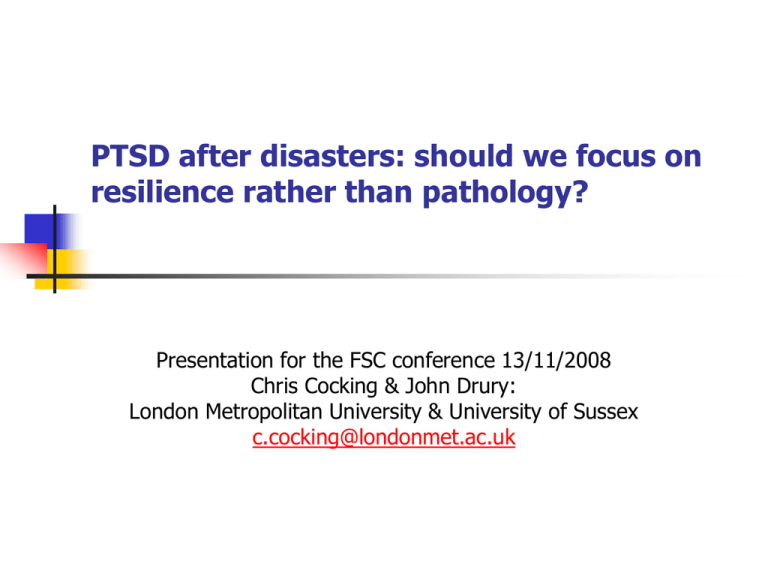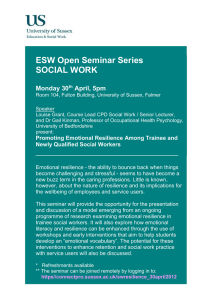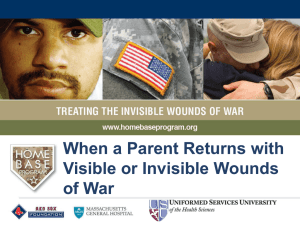PTSD after disasters: should we focus on social support and collective resilience rather than individual pathology?
advertisement

PTSD after disasters: should we focus on resilience rather than pathology? Presentation for the FSC conference 13/11/2008 Chris Cocking & John Drury: London Metropolitan University & University of Sussex c.cocking@londonmet.ac.uk Outline: PTSD- Individual and collective vulnerability or resilience? New research proposal: To investigate the relationship between PTSD and resilience/ social support after mass disasters PTSD- a clinical perspective Well known that individuals can suffer psychological trauma after stressful events Various terms used over time (neurasthenia, shellshock, war neurosis etc- Wessely 2005) Diagnostic criteria for PTSD Stressor Re-experiencing Avoidance Arousal Duration Distress or Impairment (DSM IV, APA 1994); Vulnerability PTSD after disasters, such as fires and terrorist attacks can affect between 1/3 and ¼ of participants- with crippling effects on sufferers- flashbacks, avoidance etc. But majority affected DON’T get PTSD PTSD- Individual resilience Suggested as a trait that makes some more resistant to trauma (Noppe et al 2006) Recent work emphasises possibility for post-traumatic growth in some individuals (Joseph et al 2008) Sociological perspectives on resilience Some criticise pathologisation of responses to adversity (Furedi 2004; 2007) Studies of the emergency services (Dynes 2003) and communities post disasters (Kendra & Wachtendorf 2001) emphasize spontaneous and endogenous resilience in groups and organizations ‘Social capital’ endures, even if physical & human capital don’t Resilience is the norm not the exception Organisational responses on 9/11 ‘Prior experience with 1993 WTC had led to significant learning among organisational tenants and occupants of the Towers, and planning and training contributed to their ability to respond in an adaptive fashion to highly ambiguous and threatening conditions’ (Tierney 2002) Despite EOC in WTC 7 being lost! 99% of occupants of towers below where the planes hit managed to escape (USA Today) Concept of emergence- spontaneous response to disasters by individuals & organisations Popular myths about effects of disasters, terrorist attacks Cause widespread individual and collective disorganisation Which impair responsible action Which makes response and recovery problematic Which requires external authority to insure continuity of social life (from Dynes 2003) But people are often more resilient than expected Up to ½m New Yorkers expected to get PTSD post 9/11 (Booth 2002), and PTSD type symptoms experienced by up to 10% in some samples (Hoven et al 2005) But scale of psychiatric casualties much less than expected (Silver et al 2002; Bonano et al 2006) Persistent efforts to re-establish continuity of social life- in contrast to popular images of disorganization & vulnerability in the face of disaster (Dynes 2003) How resilience develops People are often resilient during emergencies Resilience appears to be related to the development of a common identity amongst those affected in response to a shared threat (Clarke 2002) Common identity encourages co-operative rather than selfish behaviour Predicted by Social Identity Model, inspired by work of Tajfel (1978) & Turner (1982) Our research (Drury et al, In Press) has found evidence for how and why this resilience Current approaches Over-protective responses from government may stunt the public’s natural resilience and resourcefulness (Furedi 2007; Wessely 2005) The crowd may be a source of strength that can help people endure emergencies (Drury & Winter 2004) Survivor self-help groups may have therapeutic benefits after the emergency Lasting Resilience? Evidence shows common identity develops in emergencies & this encourages resilience during incident (Drury & Cocking 2007) Sense of shared identity seems to arise from survivors’ shared fate in relation to the emergency itself, and is basis of mutual concern and helping behaviour We need to know more! Does resilience endure once danger is over to help shield people from PTSD? Common identity that arises during disasters may have enduring consequences for some Evidence from some survivors of benefits of mutual support groups Some seek out contact with and/or support from other survivors Suggests that sharing experiences with similar others may be beneficial But not yet tested in any systematic way Do support groups have therapeutic consequences after emergencies? Need to investigate possible psychological and health implications of any enduring social identity Evidence that lack of social support is a risk factor for PTSD (Brewin et al 2000) Usually considered in terms of support from friends/family- not those affected by incident Mutual support groups may help survivors cope with psychological trauma A new approach Appears to be need for new social psychological model linking individual and social resilience Social identity models of stress currently applied to health related areas (Haslam et al 2008) but not applied to PTSD yet, and little about nature & content of how identities emerge New model may explain how and why people survive psychologically in disasters, how the emergency services can help this process, and what this means for aftercare Future research plans Proposed research would give a greater understanding of the psychosocial factors associated with PTSD (such as social support) and encouraging resilience from its effects This could improve clinical interventions by adopting more group-based approaches If the evidence supports the suggested therapeutic role of mutual support groups for survivors in ameliorating the effects of PTSD – this could be facilitated by the health and emergency services Possible disadvantages of support groups? Not all survivors want to be in touch with other survivors- some want to forget and/or move on Support groups for emergency workers may be more popular/ therapeutic (existing strong identity, continual exposure to stress, trauma) Survivor groups can also be maladaptive, as trauma/illness may become defining part of victims’ identity- some evidence for this (Bonano et al 2005) Overview People and organisations are more resilient in emergencies than they are often given credit for But does this resilience endure, and can it be harnessed to protect people from trauma post disasters? Thanks for listening! Any questions/ comments? Any ideas of organisations/ funding councils that may fund our research plans? Current research findings available at; http://www.sussex.ac.uk/affiliates/panic/applications. html References Booth (2002) Washington Post 7/9/2002 Brewin (2003) PTSD- Malady or myth? Clarke (2002) Contexts, 1, 21–26. Drury (2004) International Journal of Mental Health Vol. 32 pp. 77-93. Drury et al (In Press). British Journal of Social Psychology. Furedi (2004) Therapy culture Furedi (2007) Invitation to Terror Haslam et al (2008) Applied Psychology: an International review Hoven et al (2005) Arch Gen Psychiatry. 2005;62:545-552 Joseph et al (2008) Trauma, Recovery & Growth Kendra & Wachtendorf, (2001) Disaster Research Center. Noppe, et al (2006) Death Studies, 30, 41–60. Tajfel et al (1971) European Journal of Social Psychology, 1, 149–177. Turner et al (1987) Rediscovering the social group: a social categorisation theory. Tierney (2002) Available at http://www.ssrc.org/sept11 Wessely (2003&5) British Journal of Psychiatry 183 (12-14) 186 (459-66) Wessely (2005) Journal of Mental Health, 14, 1-6







